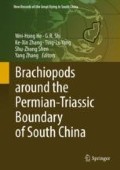Abstract
Brachiopods collected from siliceous mudstone facies, including Hushan, Majiashan, Rencunping, Xinmin, Duanshan, Shaiwa, Xiejiaping, Dengcaoba, Dongpan, Paibi and Liuqiao sections, are devoid of abrasional signs. In these sections, they occur sparsely on bedding surfaces and occasionally have articulated valves. These taphonomic features indicate that the brachiopods have been preserved mostly in situ, with little postmortem transportation and reworking.
Access this chapter
Tax calculation will be finalised at checkout
Purchases are for personal use only
References
Archbold NW. 1980. Studies on western Australian Permian brachiopods. 1. The family Anopliidae (Chonetidina). Proceedings of the Royal Society of Victoria, 91: 181–192.
Hammer Ø, Harper DAT. 2006. Paleontological data analysis. Blackwell Publishing, Malden, Oxford, Carlton, 351 pp.
Hammer Ø, Harper DAT, Ryan PD. 2001. PAST: paleontological statistics software package for education and data analysis. Palaeontologia Electronica, 4: 1–9.
Havlíček V, Racheboeuf PR. 1979. Chonetacea (Brachiopodes) du Silurian et du Dévonien de Bohême (Tchécoslovaquie). Annales de Paléontologie (Invertébrés), 65: 69–138.
He WH, Shi GR, Twitchett RJ, Zhang Y, Zhang KX, Song HJ, Yue ML, Wu SB, Wu HT, Yang TL, Xiao YF. 2015a. Late Permian marine ecosystem collapse began in deeper waters: evidence from brachiopod diversity and body size changes. Geobiology, 13: 123–138.
He WH, Zhang KX, Chen ZQ, Yan JX, Yang TL, Zhang Y, Gu SZ, Wu SB. 2015b. A new genus Liaous of early Anisian Stage (Middle Triassic) brachiopods from southwestern China: systematics, reassessment of classification of the Spiriferinioidea, community paleoecology, and paleoenvironmental implications. Journal of Paleontology, 89: 966–979.
He WH, Shi GR, Yang TL, Zhang KX, Yue ML, Xiao YF, Wu HT, Chen B, Wu SB. 2016. Patterns of brachiopod faunal and body-size changes across the Permian–Triassic boundary: evidence from the Daoduishan section in Meishan area, South China. Palaeogeography, Palaeoclimatology, Palaeoecology, 448: 72–84.
He WH, Shi GR, Xiao YF, Zhang KX, Yang TL, Wu HT, Zhang Y, Chen B, Yue ML, Shen J, Wang YB, Yang H, Wu SB. 2017. Body-size changes of latest Permian brachiopods in varied palaeogeographic settings in South China and implications for controls on animal miniaturization in a highly stressed marine ecosystem. Palaeogeography, Palaeoclimatology, Palaeoecolog, 486: 33–45.
Jablonski D. 1996. Body size and macroevolution, p. 256–289. In: Jablonski D, Erwin DH, Lipps JH. (Eds), Evolutionary Paleobiology. University of Chicago Press, Chicago and London.
Jaynes ET. 2003, Probability Theory: the Logic of Science, Cambridge, Cambridge University Press, 753 pp.
Jin YG, Sun DL. 1981. Palaeozoic brachiopods from Xizang, p. 127–176, pls. 1–12. In: Nanjing Institute of Geology and Palaeontology (Ed.), Palaeontology of Xizang, Book 3 (The series of the Scientific Expedition to the Qinghai–Xizang Plateau). Science Press, Beijing. [In Chinese with English abstract].
Ljaschenko AI. 1973. Brakhiopody i Stratigrafiia Nizhnefranskikh Otlozhenii Iuzhnogo Timana i Volgo-Ural’skoi Neftegazonosnoi Provintsii. Vsesoiuznyi Nauchno-Issledovatel’skii Geologo-Razvedochnyi Neftianoi Institut (VNIGNI), Trudy, 134: 1–279.
Raup DM. 1975. Taxonomic diversity estimation using rarefaction. Paleobiology, 1: 333–342.
Razali NM, Wah YB. 2011. Power comparisons of Shapiro–Wilk, Kolmogorov–Smirnov, Lilliefors and Anderson–Darling tests. Journal of Statistical Modeling and Analytics, 2: 21–33.
Sober E. 1983. Parsimony in Systematics: Philosophical Issues: Annual Review of Ecology and Systematics, 14: 335–357.
Stehli FG. 1954. Lower Leonardian brachiopoda of the Sierra Diablo. Bulletin of the American Museum of National History, 105: 257–358.
Swofford L. 2002, PAUP: phylogenetic analysis using parsimony (and other methods), 4.0 beta 10, programme and documentation, Sunderland, Massachusetts, Sinauer Associates, 140 pp.
Wang SC, Marshall CR. 2004. Improved confidence intervals for estimating the position of a mass extinction boundary. Paleobiology, 30: 5–8.
Wang SC, Everson PJ. 2007. Confidence Intervals for pulsed mass extinction events. Paleobiology, 33: 324–336.
Waterhouse JB. 1975. New Permian and Triassic brachiopod taxa. Paper of Department of Geology of University of Queensland, 7: 1–23.
Waterhouse JB. 1981. Early Permian brachiopods from Ko Yao Noi and near Krabi, southern Thailand, p. 47–213. In: Waterhouse JB, Pitakpaivan K, Mantajit N (Eds), The Permian Stratigraphy and Palaeontology of southern Thailand. Geological Survey Division Department of Mineral Resources, Bangkok.
Williams A, Carlson SJ, Brunton CHC, Holmer LE, Popov LE, Mergl M, Laurie JR, Bassett MG, Cocks LRM, Rong JY, Lazarev SS, Grant RE, Racheboeuf PR, Jin YG, Wardlaw BR, Harper DAT, Wright AD, Rubel M. 2000. Linguliformea, Craniiforemea, and Rhynchonelliformea (part), p. 371, 374, 385–388, 527–530. In: Williams A et al. (Eds), Treatise on Invertebrate Paleontology, Part H, Brachiopoda (revised) 2, 3, Linguliformea, Craniiforemea, and Rhynchonelliformea (part). The Geological Society of America, and the University of Kansas, Lawrence.
Yang DL. 1991. The brachiopod fauna of Early Permian early Qixia Stage, Yishan area, Guangxi and its significance. Bulletin of the Yichang Institute of Geology and Mineral Resources. 17: 81–92. [in Chinese].
Author information
Authors and Affiliations
Corresponding author
Editor information
Editors and Affiliations
Rights and permissions
Copyright information
© 2019 Springer Nature Singapore Pte Ltd.
About this chapter
Cite this chapter
He, WH., Shi, G.R., Yang, TL., Wang, YB. (2019). Materials and Methods. In: He, WH., Shi, G., Zhang, KX., Yang, TL., Shen, SZ., Zhang, Y. (eds) Brachiopods around the Permian-Triassic Boundary of South China. New Records of the Great Dying in South China. Springer, Singapore. https://doi.org/10.1007/978-981-13-1041-6_5
Download citation
DOI: https://doi.org/10.1007/978-981-13-1041-6_5
Published:
Publisher Name: Springer, Singapore
Print ISBN: 978-981-13-1040-9
Online ISBN: 978-981-13-1041-6
eBook Packages: Earth and Environmental ScienceEarth and Environmental Science (R0)

